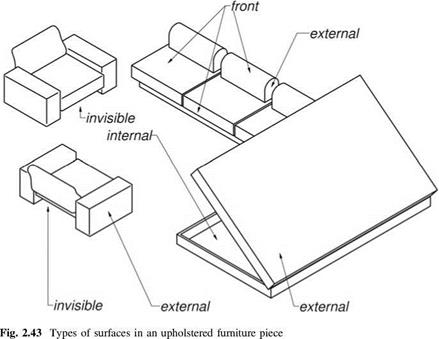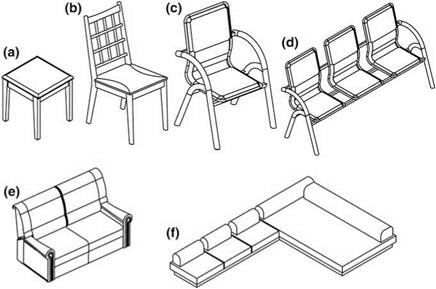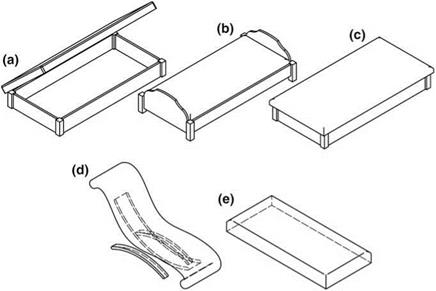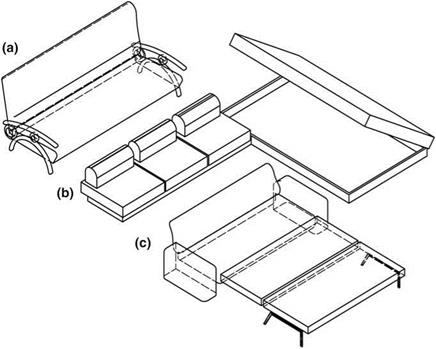Upholstered furniture belongs to a group of products of complex structure and a multifaceted manufacturing process. In the designed and used interior, furniture fulfils two main functions: usable, ensuring comfortable relaxation, recreation, sleep, etc., and aesthetics connected with enriching the decor of the room.
Upholstered furniture is products of linear, surface and volume structure. Among the large group of elements of an upholstered furniture piece, we distinguish:
• main element, without which the furniture piece cannot provide the necessary stiffness, strength and reliability (e. g. the rail of an upholstery frame),
• complementary element, without which the product does not meet the expected usability functions (e. g. the foam insert of the seat, the bottom of a container) and
• compensatory element, which can improve the quality of the bearing structure (e. g. an additional rail of the frame, additional supports and bars).
• The main elements can be made of:
• boards: chipboard, carpentry, MDF, HDF, cellular, composite with the addition of lignocellulosic particles, plywood, etc., and
• wood, metal and plastics.
Complementary elements are made of:
• natural raw materials (straw, seagrass, coconut fibre, wool, feathers, horsehair, etc.),
• elastomers (polyurethane, polypropylene), latex, and silicone and
• elastic units, and pneumatic and hydraulic units.
Compensatory elements, like main elements, can be made of:
• boards: chipboard, carpentry, MDF, HDF, cellular, composite with the addition of lignocellulosic particles and plywood, and
• wood, metal and plastics.
|
|
As a rule, an upholstered furniture piece consists of a skeleton glued over with foam, a permanent (or movable) subassemblage of the seat, backrest or bed and sewn cover. Each of these parts has characteristic surfaces, which position and visibility, in terms of the user, enable to diversify the finish and construction quality. Here, we can distinguish the following surfaces (Fig. 2.43):
• front, visible in the furniture from the standard position of use, like the surfaces of a seat, backrest and sides, with which the user comes into contact directly, as well as wooden finished surfaces of the frame,
• external, visible in the furniture like in the previous usable position, however with the difference that the user does not come into contact with these surfaces directly, e. g. the back surface of the backrest, external surfaces of the sides and armrests, sides. These surfaces are finished with coordinates, i. e. materials of identical colour as the front surfaces, but of lower quality and lower price,
• internal, visible in the open furniture piece at a normal position of use. These include surfaces of couch cases and containers for bedlinen and
• invisible, invisible in the furniture piece at a normal position of use. This includes all surfaces of covered frames and partially upholstered frames.
The seat or bed is fixed permanently to the rack, which constitutes the subassemblage of an upholstered furniture piece; however, when these parts are movable, in the form of pillows, then they are called assemblages. Naturally, such assemblages,
|
Fig. 2.44 Upholstered furniture is designed for sitting: a tabouret, b chair, c armchair, d bench, e sofa, f corner sofa |
from a commercial point of view, can be stand-alone ready products, intended for separate sale.
For functional reasons, upholstered furniture can be divided into three groups:
• for sitting: tabourets, chairs, armchairs, benches, sofas, couches and corner sofas (Fig. 2.44),
• for reclining: couches, beds, lounges, chaise lounges and mattresses (Fig. 2.45) and
• for sitting and reclining: sofa, couches, sofas with a reclining function and corner sofas with a reclining function (Fig. 2.46).
The tabouret is characterised by the simplest design. In contrast, the chair has a backrest, and an armchair also has a backrest and armrest. The bench can be a simple continuation of a tabouret structure with an increased width, as well as a richly developed form of an armchair, and also with an increased width of the seat. The construction of sofas differs from the structure of armchairs only by the width of the seat and the number of persons that can use the furniture at the same time.
The most important constituent of furniture for reclining is the bed often made as an assemblage in the form of a mattress. The simplest solution is distinguished as the recliner, which does not have a container for bedlinen and with rails fitted straight to the bed. In contrast to it, the couch has a container. A bed is usually a massive frame made from wood or wood-based materials and a mattress supported on the bearing frame. Beds usually do not have containers, which is why chests of
|
Fig. 2.45 Upholstered furniture designed for reclining: a couch, b bed, c lounge, d chaise longue, e mattress |
drawers are placed in the bedroom. The double function of the sofa-couch, called
action “couch beds”, is built from a seat and backrest joined with a container using
a special lock.
In upholstered furniture, the following elements are distinguished (Figs. 2.47, 2.48 and 2.49):
• strip, the element that complements basic construction, acting as a slider, supporter, resistant, connector, etc., and depending on the function, it might be a sliding strip, thickening strip, bearing strip, supporting strip, etc.,
• connector, a type of curve-shaped bar in bent furniture,
• bar, an element constituting additional strengthening of a structural connection, and depending on its location in the furniture piece, a bar can be longitudinal, transverse, etc.,
• leg, bearing element of the base of the furniture piece, and depending on the location in the furniture, it can be the back or front leg,
• support leg, an element fulfilling the function of a back leg and support of the backrest simultaneously in skeletal furniture for sitting,
• support legs, a bent element in the shape of an inverted U, playing the role of two support legs connected from the top in bent furniture for sitting,
• armrest, a bent element with a closed circumference, usually constituting additional strengthening of construction connections in the base of skeletal bent furniture,
|
Fig. 2.46 Upholstered furniture designed for sitting and reclining: a couch, b corner sofa with reclining function, c sofa with reclining function |
• rail, an element constituting the primary horizontal structure of the base in skeletal furniture, and depending on the location in the furniture, the rail may be frontal, side, rear, longitudinal or transverse,
• arch, a bent element in one or a few planes of an open circumference, usually constituting strengthening of connections at the base of bent skeletal furniture,
• panel, the plate element filling the space between the rails of the frame,
• support, an element supporting the armrest in skeletal furniture for sitting,
• armrest, an element constituting the support of arms in skeletal and upholstered furniture for sitting,
• shelf, loosely arranged horizontal board element for placing various objects,
• semi-rim, a bent element with an open circumference, in the shape of the letter U, usually constituting the strengthening of connections at the base of bent skeletal furniture,
• rail, the component element of the frame, and depending on the location, there are longitudinal, transverse, central rails etc.,
• post, the element that constitutes vertical reinforcement or filling in the skeleton and
• muntin, an element for filling a particular space in an openwork manner in skeletal furniture.
|
|
|
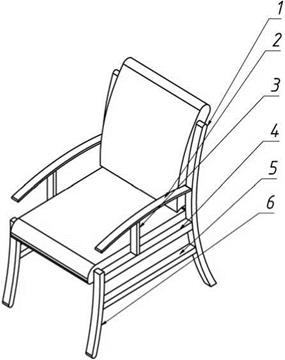
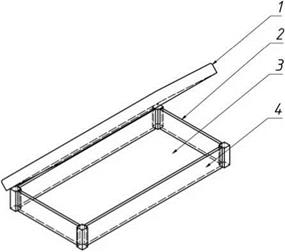
|
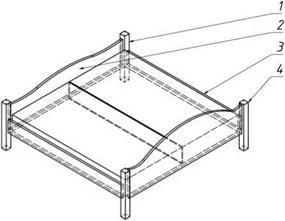
We distinguish the following subassemblages and assemblages (Figs. 2.50 and 2.51):
• side, subassemblage constituting the side limitation, often also the basis in upholstered furniture for sitting and reclining, and depending on the type of furniture, the following is distinguished: armchair side, couch side and bed side,
• bed, upholstered assemblage or subassemblage for reclining,
• mattress, type of cushion acting as a bed, the mattress can have one, two, or more parts
• backrest, an assemblage or subassemblage, upholstered or not, serving as a backrest,
• case module, an assemblage of several cases joined together,
• headrest, upholstered assemblage or subassemblage used to support the head
• in upholstered furniture for sitting and reclining,
• base, an assemblage or subassemblage that has a bearing function for the furniture piece or assemblage,
• cushion, upholstered subassemblage constituting a loosely inserted bed, seat, rest, etc.,
• armrest module, in skeletal furniture usually built from an armrest and support,
• frame, subassemblage consisting of connected rails, fulfilling the bearing function for the upholstery pillow or in the skeleton of the furniture, and in bent furniture, it can constitute a bent element with a closed circumference, and depending on the function, there are upholstery frames, side frames, door frames, etc.,
• sitting frame, a bent element with a closed circumference or U-shaped, which constitutes the main structural connection of the seat,
• seat, an upholstered assemblage or subassemblage for sitting,
• chest, assemblage fulfilling the function of a container or also the base in upholstered furniture, e. g. a chest for bedlinen,
|
|
|
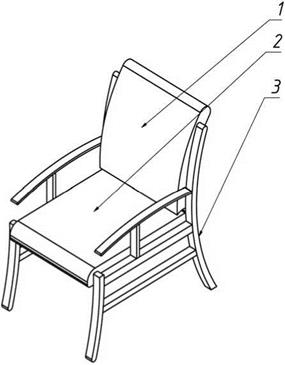
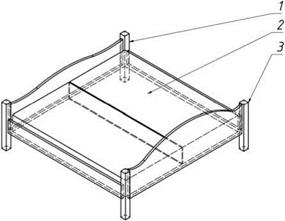
• frame, subcomponent of a skeletal structure which is a kind of base in box and skeletal furniture,
• front head, subassemblage constituting a fixed external constraint, most often also the base of an upholstered furniture for reclining from the side of the user’s head,
• rear head, subassemblage constituting a fixed external constraint, most often also the base of an upholstered furniture for reclining—from the side of the user’s legs and
• skeleton, an assemblage or subassemblage composed of structurally bound beam elements, rod elements, pipe elements, etc., which constitutes the bearing structure of the skeletal furniture or its part, e. g. upholstered.

